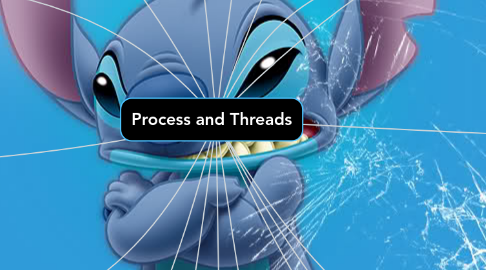
1. Five-State Process Model
1.1. Figure
2. Operating System Control Structures
2.1. OS must have information about the current status
2.2. OS constructs and maintains tables of information about each entity that it is managing.
2.3. Four different types of tables maintained by the OS
2.3.1. Memory tables
2.3.2. IO Tables
2.3.3. File Tables
2.3.4. Process Tables
3. One or More Threads in a Process
3.1. saved thread context when not running
3.2. an execution stack
3.3. some per-thread static storage for local variables
3.4. access to the memory and resources of its process
3.5. an execution state (Running, Ready, etc.)
4. Processes
4.1. unit of resource allocation and a unit of protection
4.2. A virtual address space that holds the process image
4.3. Protected access to
4.3.1. processors
4.3.2. other processes
4.3.3. files
4.3.4. I/O resources
5. Processes and Threads
5.1. Resource Ownership
5.1.1. includes a virtual address space to hold the process image
5.1.1.1. OS performs a protection function to prevent unwanted interference between processes with respect to resources
5.2. Scheduling/Execution
5.2.1. Follows an execution path that may be interleaved with other processes
5.2.1.1. a process has an execution state
5.3. Multithreading
5.3.1. The ability of an OS to support multiple, concurrent paths of execution within a single process
5.4. unit of resource ownership is referred to as a process or task
5.5. unit of dispatching is referred to as a thread or lightweight process
6. Single Threaded Approaches
6.1. which the concept of a thread is not recognized,is referred to as a single-threaded approach
6.2. Example
6.2.1. MS-DOS
7. Multithreaded Approaches
7.1. A Java run-time environment is an example of a system of one process with multiple threads
8. OS Management of Application Execution
8.1. switched among multiple applications so all will appear to be progressing
8.2. Resources are made available to multiple applications
8.3. The processor and I/O devices can be used efficiently
9. A process can be defined as
9.1. a program in execution
9.2. an instance of a running program
9.3. the entity that can be assigned to, and executed on, a processor
9.4. a unit of activity characterized by a single sequential thread of execution, a current state, and an associated set of system resources
10. Process Elements
10.1. Program code
10.1.1. which may be shared with other processes that are executing the same progra
10.2. A set of data associated with that code
10.2.1. when the processor begins to execute the program code, we refer to this executing entity as a process
10.2.2. when the processor begins to execute the program code, we refer to this executing entity as a process
11. Process Control Block
11.1. Contains the process elements
11.2. Created and managed by the operating system
11.3. Key tool that allows support for multiple processes
12. Process State
12.1. Trace
12.1.1. sequence of instructions that execute for that process
12.1.2. showing how the traces of the various processes are interleaved
12.2. Dispatcher
12.2.1. small program that switches the processor from one process to another
13. Two-State Process Model
13.1. Running
13.2. Not-Running
14. Process Creation
14.1. Process spawning
14.1.1. when the OS creates a process at the explicit request of another process
14.2. Parent process
14.2.1. is the original, creating, process
14.3. Child process
14.3.1. is the new process

